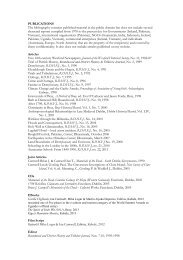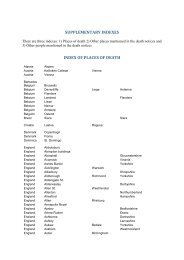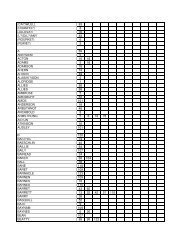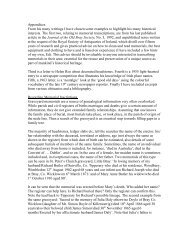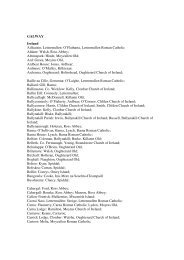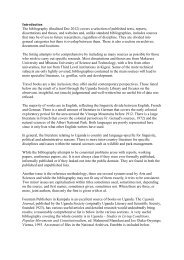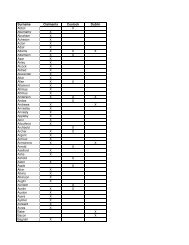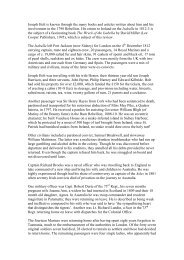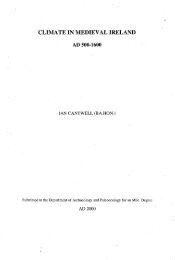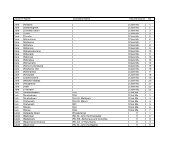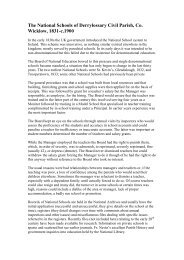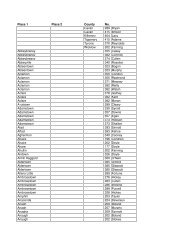include the creation ofa saintly aristocracy92, the advertising ofGlendalough as a placeofpilgrimage and learning, the establishment ofrights over daughter houses and lands,and changing dynastic interests, the latter two which can change over time. As a resultthe end result is a stratified layer of legends and motifs 93 . These motifs come in theform ofheroic sainthood based on conception, birth, boyhood deeds, adult adventuresand death with their associated miracles. 94The only accepted fact on St. Coemgen is that he probably was a member ofthe DaIMessin Corb and that he may have come from Tipperkevin, Co. Kildare 95 . His Vitaestates that he came to Glendalough initially as a hermit which is believed to be themodem Glendalough valley. It is worth considering the possibility that, presuming it isaccurate, that he first settled in the Clohoge valley as this also topographically is avalley oftwo lakes. There are five small circular hut sites on the western flanks aboveLough Tay96 which may be the remnants ofa hermitage. O'Hanlon, in 1855, collecteda tradition that St. Coemgen had lived in the valley and some ruins on the eastern sideofthe river, near the confluence with Lough Tay, were pointed out 97 .After the death ofSt. Coemgen his cult spread widely in Leinster and into Munster andUlster and Dal Riada, via Bangor. This can be seen in it's political context: manymonastic leaders were members of ruling dynasties and therefore shared the sameagendas and channels of expansion 98 . It is possible to overemphasise political links atthe expense of spiritual links as in the 6th and 7th centuries it can be seen that acommunity ofinterests were at work in the spread ofChristianity. In a sense the spread920 Corrain D., Legend as Critic" The Writer as Witness, eelT. Dunne, Historical Studies, XVI,1987"p.2793Doherty Charles" The Irish Hagiographer, in ibid. p. 1394ibid pp. 12-139~ Sbamhrain, op. cit. pp. 111-296Groganet at (1997), DOS.746-S0970 'Hanlon John, Lives ofthe Irish Saints. Vol. VI, Dublin, ad, pp. 36-798Mac Sbamhrain, op. cit. p. 17127
of cults mirrors the ideology and practice of the Peregrinatio. Map 4 99 shows theoverall spread ofCoemgen's cult outside Leinster into the further reaches of'Dal Riadakingdom 1OO . This was a two-way process with cult diffusion (i.e. Mo Chonnoc andPetroc ofCornwall) being transmitted in both directions and the overall picture showsthat Glendalough had wide ranging contacts with Munster, East Ulster and Britain 101.It is not the purpose of this paper to cover Glendalough's political or archaeologicalplace in Ireland as these have been well covered by Mac Sbamhrain and Long in theworks previously cited. The purpose will be to try and highlight some ofthe settlementconsequences for the valley and plateau.Glendalough: Settlement and EconomyFrom the first century the lithology of the Lower lake in Glendalough changes fromgleys to predominantly peat deposits which are likely to be the secondary depositionfrom upland bogs. Sedimentation is happening at a faster rate probably due to the lossof tree cover. In the middle of the 5th century the pollen diagram shows anothershort-term clearance phase ofmostly oak and birch which coincides with an increase ofgrass pollen and charcoal deposits. This does not appear to be sustained as there islater regeneration ofboth tree species. In the middle ofthe 7th century there is anotherclearance phase of oak and hazel with no great change in grass pollen but an increaseof ferns which may indicate clearance for wood but not for agriculture as both grassand cereal values remain low. It is difficult to interpret this as the sources forGlendalough are few with three references (excluding the death of St. Coemgen) forthe centuryl02. It may be that after the founding ofthe monastery there was a declinebut one cannot over interpret the pollen data as the economic linkages with the rest ofLeinster may mean that agricultural produce was imported.99 ibidlooibid. p. 67..9IOlibid. p. 122..5l02 ibid . p. 11228
- Page 1 and 2: SOCIETY AND SETTLEMENTINGLENDALOUGH
- Page 3: INTRODUCTIONIn 1990, due to family
- Page 6 and 7: "Geography is a permanentfactor in
- Page 8 and 9: ACKNOWLEDGEMENTSI am deeply indebte
- Page 10 and 11: MEmODOLOGYIn 1996 two important wor
- Page 12 and 13: The fourth was the primary research
- Page 14 and 15: have been a tributary of the Avonmo
- Page 16 and 17: Pre-HoloceneAt the end of the perio
- Page 18 and 19: 4,6Q0-4,200BP, with an increase of
- Page 20 and 21: diagnostic ofhigh population pressu
- Page 22 and 23: Map2 Pre-Historic archaeology~. ._
- Page 24 and 25: must be careful in interpreting the
- Page 26 and 27: may be Downemore in Glassnamullen b
- Page 28 and 29: Knockadreet (Cnoc a' droichead); th
- Page 30 and 31: What is worth noting is the continu
- Page 34 and 35: v1ap 4 Diffusion ofSelected Saints:
- Page 36 and 37: From around the ninth century Giend
- Page 38 and 39: Glendalough: Politieal contextDurin
- Page 40 and 41: understanding medieval ideologies,
- Page 42 and 43: Glendalough: Abbey and BishoprieIn
- Page 44 and 45: low density which he explains by th
- Page 46 and 47: known how well this represents cont
- Page 48 and 49: Parish of Glendalough in the 1821.
- Page 50 and 51: What is unclear is the amount of un
- Page 53 and 54: The charters ofconfirmation to the
- Page 55 and 56: Dublin, John Cumin, was in exile 11
- Page 57 and 58: must pay for the wood 209 . This gr
- Page 59 and 60: appears to be the continuation ofth
- Page 61 and 62: 'IIIRoad to Plateau,,-- --Map 8 Cas
- Page 63 and 64: ecame Archdeacon of Glendalough and
- Page 65 and 66: obscure and even the great expert,
- Page 67 and 68: Glassnamullen was hived offfrom the
- Page 69 and 70: CHAPTER 4CONQUESTANDSECULMUSATIONPo
- Page 71 and 72: Glenmalure, but the fact that descr
- Page 73 and 74: I Map 9 Politics and Conquest - 130
- Page 75 and 76: Castlekevin under siegeThe impact o
- Page 77 and 78: transition from grain to pastoral a
- Page 79 and 80: CHAPTERSDECLINE, RESURGENCE AND EXT
- Page 81 and 82: Resurgence - The political backgrou
- Page 83 and 84:
ofthe lowlandsofthe Pale andthe ber
- Page 85 and 86:
which were put into execution in th
- Page 87 and 88:
succumbed to the Gaelic Dream when
- Page 89 and 90:
year. However it was agreed and con
- Page 91 and 92:
Whigmanstown, Glasmollin and Tollag
- Page 93 and 94:
By 1636 there is a well utilised la
- Page 95 and 96:
integration into English and Europe
- Page 97 and 98:
SettlementThe Hearth Money Rolls of
- Page 99 and 100:
can be organised differently to a s
- Page 101 and 102:
Over the period there are various p
- Page 103 and 104:
APPENDIXlPOLLEN RESEARCH IN GLENDAL
- Page 105 and 106:
Notwithstanding the problems ofinte
- Page 107 and 108:
Glendalough, Co. Wicl\lowPoll en Pe
- Page 109 and 110:
CALIBRATION OF RADIOCARBOAGE TO CAL
- Page 111 and 112:
advantage to be able to return to t
- Page 113 and 114:
eformers such as LanfrancofPavia an
- Page 115 and 116:
His canonisation is an excellent ex
- Page 117 and 118:
In conclusion the history ofthe Chu
- Page 119 and 120:
Castlekevin LineArtOge----------1--
- Page 121 and 122:
Inquisition at Castle Keuyn. 1257-6
- Page 123 and 124:
I went to view.the lands of the Var
- Page 125 and 126:
In the Study area the main element
- Page 127 and 128:
ABBREVIATIONSAlen'sReg.: Calendarof
- Page 129 and 130:
Cantwell Ian, DiamondHill, RD.H.F.J
- Page 131 and 132:
Long Harry, Three Settlements ofGae
- Page 133 and 134:
Smyth AlfredP., Kings, Saintsand Sa



